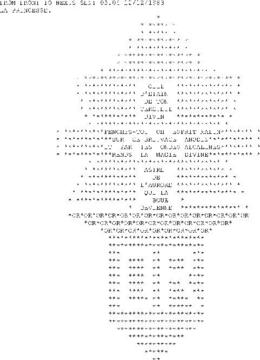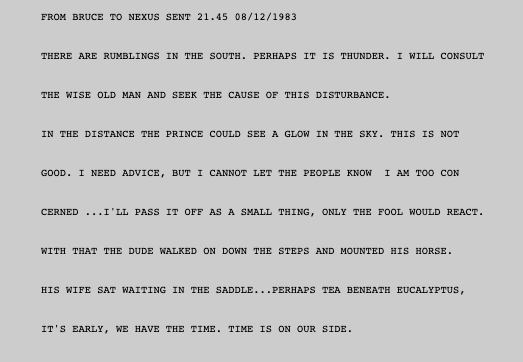
In 1983, Roy Ascott launched a call for participation in La Plissure du Text, with the aim of creating “a text of a fairy tale generated by artists located in Austria, Australia, Canada, Holland, France, Hawaii, England, Wales and the USA”. Within this fairy tale, the participating artists were assigned different roles, including villain, hero, false hero and prince and encouraged to contribute to the generated text from the perspective of this archetypal character.
“I set up this planetary fairytale. We had fourteen nodes across the world, Australia, Hawaii, Pittsburgh, various places, … Vienna, Amsterdam, and so forth. And to each node I ascribed an archetypical fairytale character. […]
Roy Ascott, 1983 (via Medien Kunst Netz)
Over a period of three weeks started a narrative, that could be either in English or in French, it wasn’t a matter of translation, had to be just English or French because it was IN Paris, and so forth. To start it off—I played the part of a magician in Paris, so I would naturally say, «Once upon a time…» and then others from their point of view-the Wicked Witch or whatsoever—would pick up the narrative, and develop it online. So that what was happening was you would go on line, and you would see the story so far, and then input.”

La Plissure du Texte was active continuously from 11 to 23 December. Each participant sent in their text contributions to the fairy tale over the ARTEX computer network. Although the project should have created one version of the text, for unknown reasons, all of the participating locations had slightly different versions. Therefore, there is no definitive final version.
La Plissure du Texte enables a mid-deep level of hybridity. The project is spread across a series of different locations where teams are working collaboratively on-site. These teams are then working in a further digital collaboration using the ARTEX computer network, to produce a single piece of work together.
Over three weeks, participants could simply go online, read the existing contributions, and continue the story from there. This allowed for a collaborative process without a strict time window. Although they couldn’t edit previous parts, the participant artists could continue the fairy tale as they wished. The final product was a collaborative effort where each participating artist had equal agency in dictating the direction of the narrative.
Credits
- Concept: Roy Ascott
- Network organisation: Robert Adrian
- Coordinators at the various locations: Bruce Breland (Pittsburg); Hank Bull (Vancouver); David Garcia/Annie Wright (Amsterdam); Eric Gidney (Sydney); Helmut Mark/Zelko Wiener (Vienna); Greg McKenna/Tom Klinkowstein (San Francisco); John Southworth (Honolulu); Norman White (Toronto)